
The Internet's Premier Classical Music Source
Related Links
- Latest Reviews
- More Reviews
-
By Composer
-
Collections
DVD & Blu-ray
Books
Concert Reviews
Articles/Interviews
Software
Audio
Search Amazon
Recommended Links
Site News
 CD Review
CD Review
Seraphim Reissues
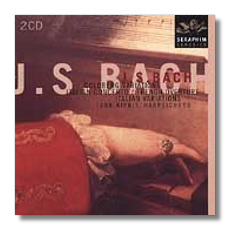
Johann Sebastian Bach
- Goldberg Variations
- Partita in B minor (French Overture)
- Variations in the Italian Style
- Italian Concerto
Igor Kipnis, harpsichord
Seraphim CDR 5 74501 ADD 2CDs: 73:37, 70:34

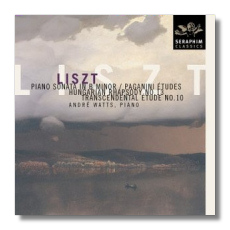
Franz Liszt
- Sonata in B minor
- Six Grand Études After Paganini
- Hungarian Rhapsody #13
- En rêve
- Transcendental Étude #13
André Watts, piano
Seraphim CDR 5 74504 2 DDD 75:40

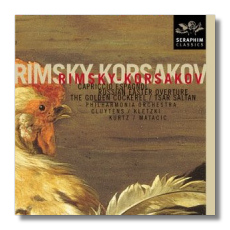
Nicolai Rimsky-Korsakoff
- Tsar Saltan: Suite
- The Golden Cockerel: Suite
- Russian Easter Overture
- Capriccio espagñol
Philharmonia Orchestra/Paul Kletzki, André Cluytens, Lovro von Matacic, Efrem Kurtz
Seraphim CDR 5 74518 ADD 78:42

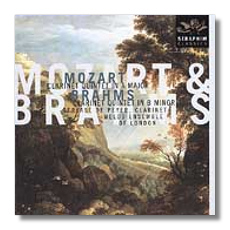
- Wolfgang Mozart: Clarinet Quintet in A Major
- Johannes Brahms: Clarinet Quintet in B minor
Gervase de Peyer, clarinet
Members of the Melos Ensemble
Seraphim CDR 5 74520 ADD 65:05

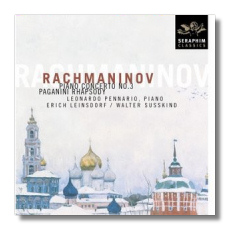
Sergei Rachmaninoff
- Piano Concerto #3
- Rhapsody on a Theme of Paganini
Leonard Pennario, piano
Philharmonia Orchestra/Walter Susskind
Los Angeles Philharmonic Orchestra/Erich Leinsdorf
Seraphim CDR 5 74522 ADD 62:17
In the LP era, Seraphim reissues were "Angels of the Highest Order." As more modern recordings came along, old favorites, stereophonic and monaural, were released on Seraphim at a fraction of their original price. Since CDs came along, a higher value has been placed on "classic" recordings, and they appear at budget prices less frequently. However, there's no shortage of material from the 1950s, 60s, 70s, and 80s that remains powerfully satisfying today. That was a Golden Age for classical music on disc, although we didn't always realize it at the time. Today's Seraphims, now more than ever, dip into the back catalog and resurrect material that does not deserve to fall in the crack between "classic" and modern recordings.
Igor Kipnis (son of basso Alexander Kipnis) recorded prolifically in the 1960s and 70s, yet only a few of his older recordings have found their way to CD. A wrong is righted with the two-CD Seraphim reissue of more of his Bach. (Seraphim reissued the six Partitas last year.) If you think of the harpsichord as tinkly and ineffectual, you'll probably be surprised by Kipnis's sound, which roars when Bach's music suggests that leonine strength is needed. His instrument is a 1970 copy of a design by Hass, made by the Rutkowski and Robinette firm in New York City. Capable of charming, even cooing delicacy, it also has almost orchestral power and versatility. Kipnis's exciting interpretations have aged very well, even though they predate the rise of the "more authentic than thou" movement in Baroque performance practice. Crisp, dancing rhythms enliven the faster music, and the slower music is thoughtful but never dragging. Kipnis takes repeats (his Goldberg Variations, spread across two discs, come in at around 84 minutes), and imaginatively and tastefully embellishes them. Wanda Landowska (to name an earlier harpsichordist) broke the ground here, but Kipnis has opened it up, making a full-length recital for harpsichord as viable as a piano recital. Very close miking seems to place the listener within Kipnis's instrument. The effect is not altogether unpleasant, however.
André Watts recorded the Liszt Sonata in B minor and the six Paganini Études for Sony (then Columbia Masterworks) in 1970. These dramatic readings have been reissued in Sony's budget-priced Essential Classics series (SBK 62664). The digital remakes released here on Seraphim come from 15 years later, after Watts's flame had cooled somewhat. Here, the pianism is more subjective and less splashy. The impressionistic nocturne En rêve gives Watts his finest moment on this disc. All shades and half-tints, it is a painting by Turner turned by alchemy into music. In the showiest works, specifically the Hungarian Rhapsody #10 and the Paganini Étude "La Campanella," Watts's playing suggests that he has the flesh for such music, but not necessarily the spirit that he once had. That characteristic distinguishes pianists from singers, who lose the physical ability to dazzle before they lose the will to do so! While relatively muted (and almost four minutes slower), Watts's 1985 recording of the Sonata in B minor is a fine piece of architecture, as well as of intelligent virtuosity. This is the only digital reissue of the five reviewed here, and it wears its years lightly, although it is not superior to analog recordings made by EMI or Angel during the previous decade.
The Rimsky-Korsakov CD would be a fantastic option for those who know the composer's Schéhérazade and are ready to move on to something else. Sonically and interpretively, there's plenty of spectacle here. The cock-a-doodling trumpet fanfare that opens Kurtz's recording of The Golden Cockerel (Le Coq d'Or) still has an arresting impact, even though this recording is almost 40 years old. Kurtz is colorful and he tells a good story. (When working with a conductor who was associated with the ballet, these are predictable assets.) Kurtz knows when to back off, as well as when to push forward. Von Matacic's Russian Easter Overture closes with a spectacular volley of church bells. This conductor also resists the temptation to "Solti-ize" the music through excesses of tempo and emphasis. His recording is even older (1959), but no less sonically viable than Kurtz's. In the Capriccio espagñole, Cluytens builds up to an electrifying finale, and he contributes a suave "Flight of the Bumblebee" to the Tsar Saltan suite. The other three numbers from the suite are conducted by Paul Kletzki. He shares the same priorities with Cluytens, von Matacic, and Kurtz: color, controlled excitement, and orchestral discipline. The Kletzki recordings, which come from 1960, are a little less sonically impressive – the highs sound a little artificial now – but this is hardly a black mark on the CD overall. With a generous playing time and a minimal purchase price, this disc would be strongly welcomed by repertoire-builders and by collectors who are nostalgic about classical recordings from this era.
A session with Mozart's and Brahms' Clarinet Quintets, back to back, is almost too much pleasure at one sitting. Both were composed for a particular clarinetist, in recognition of that individual's impact on the composer's musical awareness. (Mozart's inspiration was Anton Stadler, and Brahms' was Richard Mühlfled.) Both are late works. They offer pleasures of a different kind, however. Mozart's quintet is essentially uncomplicated by darker emotions, although its radiance gives it an unearthly quality; surely this is what one hears in the afterlife. Brahms' Clarinet Quintet often is described as "autumnal." As its minor key signature suggests, it is more disturbed and disturbing than Mozart's opus, and struggle and resignation intermingle among its pages. It ends with neither a bang nor a whimper, but with a small, equivocal gesture – a beautiful case of musical "mixed feelings." These recordings from 1965 (Brahms) and 1966 (Mozart) are treasurable because of their high level of polish and timbral beauty. The Mozart is more successfbecause its emotional content is well served by the players' "let's play as seraphically as we can" attitudes. That's not to say that the Brahms is not wonderful. This is a reading to curl up with. However, there are other recordings that make more of Brahms' storminess. At the Seraphim price, and with mellow engineering serving as an additional incentive, there's no reason not to try this CD, particularly if you want to fall in love with the works that it contains.
Unfairly, Leonard Pennario has been associated with the light classical repertoire, and the CD era has not been generous to him a result; the implication is that he was not a "serious" pianist. A reissue such as this Rachmaninoff CD should give open-minded listeners reason to reevaluate any prejudices that they may have held against Pennario. Again and again, he proves himself to be a fine musician, with a formidable technique and stylistic savvy. This Rhapsody on a Theme of Paganini, recorded in Los Angeles in 1957, is one of the best in the catalog, particularly if you see demonism as an essential aspect of this work. Even the more sentimental variations seem mocking. This performance burns with a brilliant yet cold flame. Leinsdorf, another musician who no longer receives the respect that he once commanded, is a decisive partner who does his share to stir this witches' brew. The "Rach 3," recorded two years later in London's Abbey Road Studios, also avoids any excessively Romantic lingering. The performers inflame the concerto with febrile strength; the composer's own recorded interpretation is much closer to this one than it is to several more celebrated recent recordings. This work is on the verge of becoming too familiar. Pennario and Susskind are like a splash of cold water in the face. These Capitol recordings have transferred fairly well to CD. The string tone is thin, but the sound has an attractive warmth overall. Even someone with a large collection of Rachmaninoff will be happy to add these surprising performances to his or her collection.
Copyright © 2001, Raymond Tuttle


















